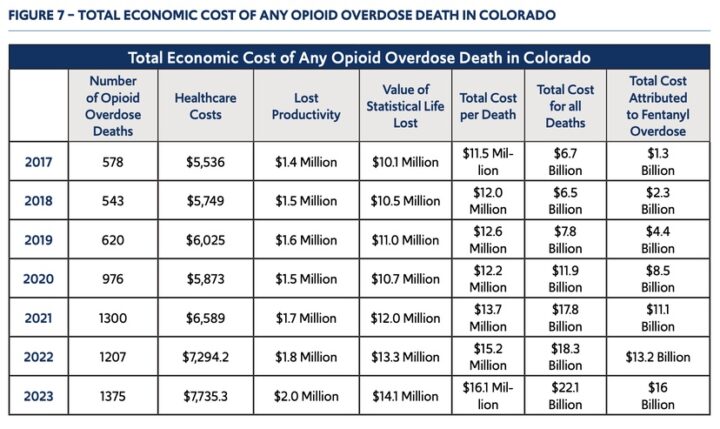When I was a kid, my parents tried to make me understand that certain things were priceless. You simply couldn’t assign a price to them. Not because they were “worthless”, but quite to the contrary, because their value was beyond measure.
In fact, my mother claimed that I was, myself, priceless. I can hear her saying it:
“Louis, you are priceless!”
Typically, she would say this in reaction to some funny joke I told, or some humorous stunt.
With that in mind, I found a recent report about fentanyl abuse and overdoses in Colorado, posted by the Common Sense Institute, to be rather interesting. It was written by Dr. Steven L. Byers.
Fentanyl has become a popular drug to kill yourself with, but that’s not why I found the report so interesting. Being myself a person with common sense, I’ve often suspected that I was not really priceless — as my mother might claim — but that I have an actual value that can be calculated.
This report made it clear that, as of 2023, I was worth more than my weight in gold. And apparently, my value keeps going up with each passing year.
Steven L. Byers, Ph.D. serves as Chief Economist with the Common Sense Institute. He’s a fifth generation Coloradan, an avid bicyclist, golfer, and sailor, and he builds houses and fine furniture in his spare time. He wrote his Ph.D. dissertation based on a Computable General Equilibrium model (CGE) he developed to evaluate the economic impact of regional tax incentives in Fort Collins, Colorado.
Anyone who can build a Computable General Equilibrium model, and also, houses in his spare time, obviously knows something about something.
His fentanyl report included a chart that looked like this:

The chart shows data about overdose deaths in Colorado from all opioids. (Not just from fentanyl.) This situation is getting worse with each passing year. This was not news to me; the mainstream media has been reporting on the problem almost weekly. But what was news to me was Column 5.
“Value of Statistical Life Lost.”
In 2017, the Center for Disease Control and Prevention (CDC) estimated the cost of an opioid overdose in Colorado. They calculated the total cost of all fatal opioid overdoses in 2017 to be over $6.7 billion. The CDC used a case count of 578 fatal opioid overdoses, a per death cost of $11.5 million. Dr. Byers subtracted the cost of Healthcare and Lost Productivity, and used that dollar amount as the “Value of Statistical Life Lost” in Column 5, for 2017. Then he increased the value of a life lost by inflation, and found that, last year, a life lost was worth $14,1 million.
I felt relieved that Dr. Byers subtracted the Healthcare costs (because I avoid hospitals like the plague) and Lost Productivity (because it seems related to productivity) and calculated that, if a person in Colorado had died last year (of causes unrelated to fentanyl) their statistical life should be valued at $14.1 million. Statistically. If lost.
I currently weigh 160 pounds. Gold currently sells for $2,442 per ounce. If I consisted of 160 pounds of gold (instead of fat, bone and muscle, in that order) I would sell for about $6.3 million.
According to the CDC and Dr. Byers, I appear to be worth about twice as much as my weight in gold. (Regardless of my productivity.)
I mentioned this calculation to my mother yesterday, and she laughed. “Oh, Louis… you’re priceless!”
Needless to say, my mother is not an chief economist.
In my opinion, however, $14.1 million is pretty darn close to being priceless.
Underrated writer Louis Cannon grew up in the vast American West, although his ex-wife, given the slightest opportunity, will deny that he ever grew up at all. You can read more stories on his Substack account.

